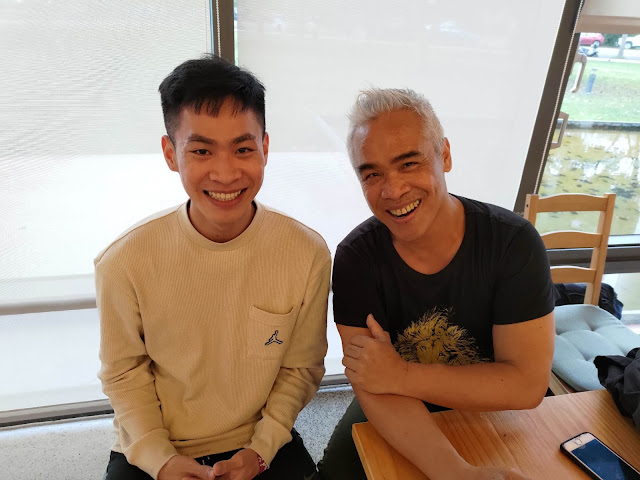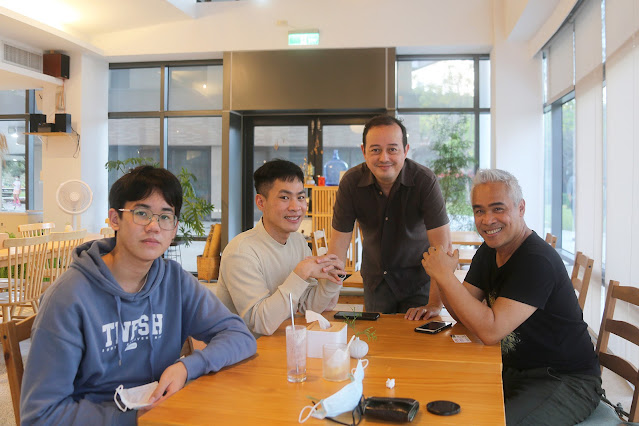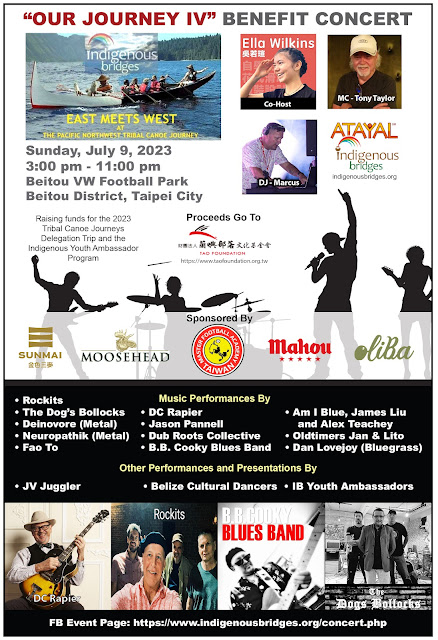Visiting Taitung in search of the meaning of my Indigenous identity
Visiting Taitung to learn more about what my own Indigenous identity means to me, I met three people whose Indigenous identities expanded their horizons and brought purpose and fulfillment to their lives.
by Xander Coolidge (陳仁德)
On February 8, 2023, during the Winter holidays, I traveled to Taitung City for four days to learn more about Indigenous culture and the possibilities that my own Atayal Indigenous identity may provide for my future. As a busy high school student in Taiwan, I only know basic information about Taiwan's Austronesian identity that is taught in Taiwanese schools. So, I valued this opportunity to learn from Indigenous people and to gain insights into what their Indigenous identities mean to them. I really don't know what my Austronesian roots mean to me and how it might influence my future, but it doesn't hurt to dig into the culture and see what is revealed in the Indigenous paradise of Taitung. I believe there is no better place to explore Taiwanese Indigenous culture than in the Southeast corner of Taiwan.
 |
| Si Mateneng during a cultural exchange trip in the USA |
One of the first Indigenous people I met on the trip was Si Mateneng (Howard). We met up at a coffee shop, where he was waiting to meet my father and another man, Yosifu. While there, I was able to learn a lot about him. Si Mateneng (Howard) is currently studying for his Masters degree in Anthropology at National Chengchi University (NCCU). He is also part of the Tao tribe from Orchid Island. The Tao islanders are well-known for their enthusiasm and warmth shown to visitors, and you can see that as well with Si Mateneng, as he always greets people with a friendly smile. From the conversations they had, I could tell that Howard took pride in himself and his culture, using it as the theme of an essay or report that he was working on. Sharing his culture with us in such passion. He is also an Indigenous Bridges Youth Ambassador for ATAYAL, and this summer, he'll be heading to Washington State in the USA to the University of Washington's Burke Museum, tasked with a job of creating a presentation of the story behind each cultural artifacts that are on display. His work will shine light on this ancient but evolving part of history to the people of the world, not letting it be forgotten.
 |
| Si Mateneng meets an inspiring role model, Yosifu. |
On the second night of the trip, I was introduced to an old friend of my father, Niwa Maibut. Under the Taitung night sky, we all had traditional Amis food, while we listen to Niwa share about her culture and a touching story about her life experiences. Niwa is a Bunun woman from a village in Taitung County, and after growing up, she chose to become an English teacher teaching at her small village. This all happened because of two benefactors in her life during her childhood. One was a pastor from her mother's church, and the other was a man from England whom she had never met until she was eighteen. Niwa was a typical inquisitive village girl until one day, the local pastor asked her if she wanted to learn English. As she accepted this invitation, her life was about to change. At the same time, behind her parents back, she signed up to be sponsored through the World Vision international charity. Lucky enough, a man from England who fought in WWII and lost his daughter, driven by grief, chose a "Formosan girl with big eyes," who was Niwa.
 |
| My father reunited with Niwa in Taitung during this trip. |
From that moment onward, her whole life turned around 180 degrees. Her family began receiving 50 Pounds (£) every month from the sponsor who lived off a small military pension. This act of kindness substantially improved the living standards of Niwa's family. To express her gratitude to the British man she had never met, she chose to write a letter, but soon, she realized how limited her vocabulary was. At that moment, the young girl decided to put more work than ever into learning English, just to be able to thank her supporter properly. She spent day and night studying English. When she was nineteen, she was finally able to meet her sponsor, and at first sight, they embraced each other tightly. They never met each other, but they were still like old friends. Few words were exchanged, yet the emotions gushed freely. One man change a girl's life for the better, while the girl soothed the man's grief-stricken heart. After this fateful meeting, at a time when even going to college was rare for a Taiwanese woman, Niwa was given the chance to study abroad in England for six months. Naturally, she took it! And subsequently, she went to University in the USA to major in English. This series of events led her to chose the path of teaching English in her village. Though having the ability to teach where ever she wants. She still chose the small school in her village, wanting to use the kindness and fortune she was given and pay it forward to the next generation.
 |
| Niwa in 2003 from the making of the documentary, Voices In The Clouds. |
The third person I met was the well-known indigenous Amis artist, Yosifu Chiu. Our main purpose for the trip to Taitung was to attend the opening of his Austronesian art exhibit at the Taitung Art Museum. During our first meeting with him, we were greeted with a big warm smile, as if we were his closest friends. And though he was very busy preparing for his upcoming exhibition, Yosifu still made the time in his busy schedule to have a discussion with me and my dad. What caught my attention though, was how his own culture affected his own career.
Yosifu was born to Amis parents, yet he went to traditional Chinese school in the city of Taipei. He was disconnected from his own Indigenous roots, and also facing discrimination for having darker skin. He felt no belonging to both the Chinese group and Amis group. He was lost. So, he decided to go abroad to England in search of his own path.
Through hardship, he eventually became an artist and made several good friends along the way. And when his friends showed their admiration and jealousy of his honey-brown skin, as he says, it was the first time he was ever praised for being just himself. Being in this positive environment, finally, after a long time, he has begun to love himself again. Though Yosifu's art was good, the style of art he chose, modern Western art, was common and lacked uniqueness. Yosifu's friends, knowing his Indigenous background encouraged him to portray his own culture. He did try, but the lack of knowledge about his own Amis or any Indigenous culture was an impediment to his creativity and ideas. So Yosifu decided to fly back to Taiwan and study his own culture and roots for six months. Step by step, he slowly unraveled the mystery that is a lost part of him. And as the fog cleard up, he finally understood who he truly is, and became whole again. After bringing his culture into his art, it felt alive and beautiful, it became something special. Yosifu's popularity then blossomed day by day. His reputation also traveled overseas, gaining recognition by more people and big companies such as Rolls Royce, McDonalds, and the New York City Subway System. In Taipei, he also made designs for many companies with his culture incorporated into it.
 |
| Yosifu introducing his exhibition during his opening ceremony. |
During my visit to Taitung City, Yosifu was there to share his 20 years of growth as an artist in an exhibition at the Taitung Art Museum. Personally, while experiencing the opening ceremony and walking through the exhibition, I was left with astonishment and felt emotional. One could tell how much effort, time and thought he spent in all his works. All with the Austronesian culture deeply carved into each of his pieces. Each peice a story of its own.
It's amazing to see how Yosifu's own Indigenous identity influenced him throughout his life, starting with his feeling of being lost and rejected, to accepting his identity with open arms and allowing it to carry him further than he could imagine. It's a heartwarming story with a happy ending. Now, Yosifu not only focuses on making art, but he is also taking part in being an ambassador for his Amis tribe and all the other Indigenous tribes, sharing their beauty and culture with the world. From a bullied Indigenous kid to a well-known world figure, his identity played a key role along his journey. This gives me hope and strength to face those who mock me and my Indigenous heritage.
This trip to Taitung was truly enjoyable, the deep blue Pacific Ocean right beside the lush green mountains, the fresh air was ubiquitous, and having affordable yet mouthwatering food every day, it was as if I was on vacation. But what I enjoyed the most out this trip was the chance to be introduced to new and interesting people. Being able to hear about not only their personal stories, but also hearing what they have to say about their cultures, the good and the bad, the problems and their solutions. It is truly the highlight of this trip.
 |
| Si Mateneng (Howard) |
Meeting Si Mateneng impacted me the most, as our age was the closest compared to the other people I encountered. However, the differences in how our Indigenous identities shaped us was contrasting. He is exceptionally proud of his Tao culture, sharing it in his reports and essays. With a goal of having more and more people to realize such a culture exists. He also wants more of the Indigenous kids to understand how important their culture is and to accept it into their lives.
Niwa's emotional story was a tear-jerker, seeing how one person's kindness to another nurtured growth and was passed down to the next generation. It may seem as if Niwa's culture had nothing to do with this, but on the contrary, she wants to give the next generation of Indigenous people the chance that she was given. Giving back to the village that gave her a chance to create her life. She's the pride of her village.
 |
| Standing among VIPs at Yosifu's Opening Ceremony. |
Yosifu's successes and achievements, which were recognized by VIPs in Taiwan and by many fans around the world, were very unexpected. Of course, the successes were earned through many hard work and adversities. But in the end, it was the assimilation of his Indigenous culture into his art that made him stand out from the rest of the crowd. Which made me realize that my Indigenou identity is not a setback or something to be ashamed of, rather it's something unique and to be proud of.
 |
| Visiting a local Rukai elementary school in the village of Taromak. |
I'm currently on the path of finding what I want to be and do in the future, but after this experience of getting to see how different people use their Indigenous identity to assist them in their life, maybe I could do the same. Though it's still unclear what lies in my future, but if used wisely, my Indigenous identity can always be a useful tool for any career path I may choose. But I'll have to dig deeper and reconnect with my roots, accepting and relearning this old yet beautiful culture that is a part of me... a part of who I am.
 |
| A poster of Yosifu's Art Exhibit. |





Comments
Post a Comment